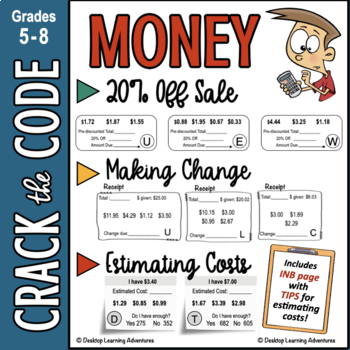Money – Making Change, 20% Off, Estimate Cost Crack the Code
- PDF
Also included in
- Math Practice Activities Crack the Code Super Bundle for grades 5-7 includes over 40 Crack the Code self-checking puzzles practicing a variety of math skills. Many of the selections are differentiated so that all ability levels are challenged. These engaging activities are loaded with mental mathPrice $52.25Original Price $67.25Save $15.00
- If you’re looking for a way to teach life skills that gives kids the opportunity to see what it’s like to have the financial responsibilities of an adult, this Project-based Learning Simulation is it! In this financial literacy unit, kids will confront the challenges we all face as they try to makePrice $26.32Original Price $29.25Save $2.93
Description
How many times have you been in a store and the cashier had no idea how to figure out how much change you should get back? Registers do all the thinking for them. But what happens when the register doesn't have that function? (Yes, they do still exist.) Counting Change puts students firmly in the driver's seat calculating change for each customer.
Money: Making Change, 20% Off Sale, and Estimating Costs is a much-needed group of 3 Crack the Code puzzles giving your students real-life, practical application with money. All puzzles are self-correcting for immediate feedback. Teacher notes and answer keys are included.
20% Off Sale challenges students to determine 20% off the regular (given) price of 3 or 4 items per ticket. This problem makes a good computation or calculator problem - or both!
Estimating Costs is a mental math challenge asking students to estimate a sum for 3 or 4 prices and determine if they have enough to pay for these items.
This code includes an Interactive Notebook page with tips for estimating money and a sample problem since this format is a little different than the others. It also includes an extra challenge for early finishers.
Skills include:
♦ adding & subtracting decimals
♦ problem-solving
♦ figuring 20 percent
♦ rounding decimals to nearest hundredth
♦ estimation
♦ mental math
Quotes:
“Somewhere inside all of us is the power to change the world.” Roald Dahl
“Genius without education is like silver in the mine.” Benjamin Franklin
“When in doubt, tell the truth.” Mark Twain
Ways to use Crack the Code puzzles~
- Centers
- Go-to Activities
- Fun Class Challenge
- Small Group Challenges
- Paired Work (Buddy up!)
- Test Prep
- Homework
- Sub Days
- RTI
Click HERE for additional Crack the Code math practice puzzles your kids will enjoy!
***************************************************************************
Customer Tips:
How to get TpT credit to use on future purchases:
Please go to your My Purchases page (you may need to login). Beside each purchase you’ll see a Provide Feedback button. Simply click it and you will be taken to a page where you can give a quick rating and leave a short comment for the product. Each time you give feedback, TpT gives you feedback credits that you use to lower the cost of your future purchases. I value your feedback greatly, as it helps me determine which products are most valuable for your classroom, so I can create more for you.
Be the first to know about my new discounts, freebies and product launches:
Look for the green star next to my store logo and click it to become a follower. Voila! You will now receive email updates about this store!
Thanks for stopping by! Pam Kranz
***************************************************************************
© Pamela Kranz Desktop Learning Adventures All Rights Reserved







